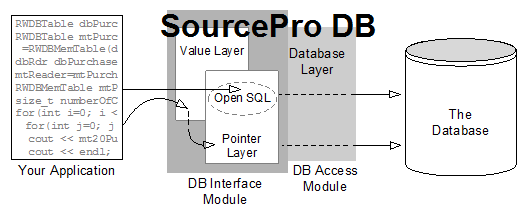The SourcePro DB Solution
To insulate your applications from the details of diverse data types, SourcePro DB uses a data model that automatically normalizes data types. By normalizing data types, we mean that SourcePro DB converts data from database-dependent data types to DB Interface Module classes that represent the data in a standard, vendor-neutral way. Figure 4 shows how this data model works within the SourcePro DB architecture:
Figure 4 – Data model of SourcePro DB 

As Figure 4 shows, SourcePro DB consists of the DB Interface Module and a vendor-specific DB Access Module that bridge your application and the database. The SourcePro DB data model consists of three layers: the database layer, the value layer, and the pointer layer.
NOTE: You can write applications with the DB Interface Module using pass-by-value semantics alone. This design avoids the memory-management concerns of pointer-based interfaces.
All classes of the DB Interface Module produced from an RWDBDatabase or RWDBTable instance, such as RWDBSelector, RWDBInserter, and so on, can accept input from, or deliver output to, the C++ types and concrete classes listed above. Insulation from the datatype and data transport peculiarities of various databases makes SourcePro DB applications portable and reusable. The remainder of this chapter describes each layer of the data model in detail.





